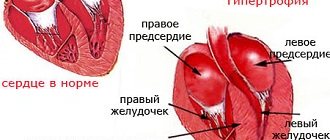Increased blood pressure can otherwise be called arterial hypertension.
Arterial hypertension occurs for a long time without obvious manifestations. However, soon enough it can lead to acute cerebrovascular accidents in the form of TIA (the so-called transient ischemic attack or, in other words, all manifestations of a stroke, but within 24 hours), strokes, as well as to hypertrophy of the walls of the heart and/or enlargement of cavities hearts.
In addition, arterial hypertension is a risk factor for the formation of atherosclerotic plaques in blood vessels and the occurrence of myocardial infarction.
The relationship between blood pressure levels and the risk of cardiovascular disease is linear.
The higher the blood pressure, the greater the likelihood of myocardial infarction, stroke, heart failure and kidney damage.
The prevalence of arterial hypertension (AH) in the Russian Federation is 39.3% among men and 41.1% among women, while blood pressure is properly controlled in only 17.5% of women and 5.7% of men.
Systolic blood pressure increases steadily with age, while diastolic blood pressure rises until age 60 in men and age 70 in women, after which it tends to decrease.
WHAT IS SYSTOLIC DIASTOLIC AND PULSE PRESSURE
Blood pressure is the pressure that blood exerts on the walls of the arteries.
There are:
- systolic pressure
- diastolic pressure
- pulse pressure
Systolic pressure (upper)
This is the maximum pressure in the arterial system developed during contraction of the left ventricle.
It is determined by the volume of blood that the heart pumps out in one contraction, as well as the elasticity of the aorta and large arteries.
Diastolic pressure (lower or heart)
This minimum pressure in the arteries during relaxation of the heart is determined by the amount of tone of the small arterioles.
Pulse pressure
This is the difference between systolic and diastolic blood pressure.
So the reasons for high blood pressure:
How to Prevent the Dangers of High Blood Pressure
When diagnosed with hypertension, a full examination is required to find the cause due to which the pathology develops. At the same time, it is important to stabilize indicators in order to reduce the risks of developing a crisis and complications.
- You need to measure your blood pressure several times a day, preferably at the same time. It is better to record the data and take it to a doctor’s appointment - this will allow you to track the dynamics and identify patterns.
- Under no circumstances should you stop taking prescribed medications on your own. If persistent improvement occurs during therapy, patients often stop taking medications. You can't do this. Cancellation, reduction of dosages, replacement of one drug with another is carried out only under the supervision of a doctor.
- It is necessary to adhere to a daily routine and avoid overwork. It is easier for the body when the usual rhythm is not disturbed.
- At the first sign of deterioration, seek help. Fluctuations in indicators and progression of hypertension can cause a crisis, heart attack, or stroke, so any changes should be reported to the doctor to adjust therapy or conduct additional examination.
Since hypertension affects all organs and systems, regular restorative and supportive courses are recommended for blood vessels, heart, and other organs as indicated.
Possible complications of isolated hypertension
The situation when the upper pressure is high and the lower pressure is normal is called isolated hypertension by experts. The disorder is associated with a decrease in the degree of distensibility of the arteries, including the most important one - the aorta. It is she who is normally responsible for receiving blood and suppressing pressure during cardiac output. Elasticity allows blood flow to pass smoothly, but as the rigidity of the arterial walls increases, this ability is lost. Blood cannot circulate through the vessels at an optimal speed, which provokes pressure surges. Small vessels are not affected, so lower pressure readings remain normal.
Over time, this condition can lead to a number of additional disorders, among which the following can be noted:
- heart failure;
- decreased left ventricular function;
- disturbance of the speed of blood flow through large vessels;
- damage to the endothelium and subsequent replacement of deformed areas with rigid connective tissue;
- increased production of enzymes that negatively affect the vascular walls - nitric oxide, angiotensin, renin.
What to do in this case? Treat. Moreover, not only relieve a person from unpleasant symptoms, but also eliminate the cause that caused the disorder. The sooner the problem is diagnosed, the answer is given to the question of why the upper pressure is high and the lower pressure is low, and a treatment regimen is drawn up, the faster you can get rid of the disease and the lower the risk of developing all kinds of complications.
Important! You cannot take medications or be treated with traditional methods without consulting your doctor.
Diagnostics
During the initial examination, the cardiologist performs a physical examination and measures the pressure in the arms and legs. To obtain the most reliable results, 24-hour blood pressure monitoring (ABPM) is prescribed. The diagnostic search is aimed at finding the etiological factors that caused high blood pressure. The examination plan usually includes:
- ECG.
According to the electrocardiogram, signs of myocardial hypertrophy and disturbances in repolarization processes are revealed. When blood pressure changes towards higher levels, single extrasystoles and other rhythm disturbances may occur, and manifestations of congenital or acquired cardiac malformations may be detected. - Ultrasound.
Echocardiography evaluates heart function. Left ventricular myocardial hypertrophy is often visualized. To exclude renal hypertension, an ultrasound of the kidneys and Doppler sonography of the renal arteries are required. According to indications, sonography of the main endocrine glands is performed. - Standard tests
. A general blood test and fasting glucose level are measured. In a biochemical study, the levels of urea and creatinine are studied, the lipid spectrum is the levels of cholesterol, different fractions of lipoproteins. In a general urine test, the amount of protein and cellular elements is determined. - Advanced laboratory tests
. If there are typical symptoms of endocrine pathology, the level of a number of hormones is examined: corticosteroids, aldosterone, catecholamines. To assess renal function, creatinine clearance is calculated. To exclude metabolic syndrome, a glucose tolerance test is recommended. - Additional instrumental studies
. To determine the cardiothoracic index, the shape and size of the heart, a survey radiography of the OGK is performed. To confirm atherosclerotic vascular damage, angiography is performed. For a more detailed study of the structure of the kidneys and adrenal glands, CT and MRI are prescribed.
When to see a doctor?
A single increase in pressure is not considered a pathology, therefore, after the first case of high numbers on the tonometer, it is necessary to measure the indicator for several more days in a row.
If blood pressure is persistently elevated or is within high normal values (130–139/85–89 mm Hg), you should consult a physician or cardiologist. The doctor will determine an action plan to identify the cause of the pathology and normalize the pressure. It is important not to delay your visit to a specialist: the sooner you start treatment, the easier it will be to control your blood pressure in the future. In the initial stages of the disease, it may be enough to reconsider your lifestyle and follow a diet. If treatment is late, lifelong medication use is inevitable.
Causes of pathology
Secondary form of ISAH
Secondary ISAH is a complication of a number of pathologies:
| Group of diseases | Specific diseases |
| Hereditary and congenital disorders | Coarctation (narrowing) of the aorta Patent ductus arteriosus Polycythemia (increased red blood cell count) |
| Cardiac and vascular disorders | Complete atrioventricular block (impaired heart contraction) Aortic valve insufficiency Atherosclerosis of the renal arteries Aortoarteritis (inflammation of the vascular lining) |
| Other violations | Anemia Fever Thyrotoxicosis (high level of thyroid activity) |
Primary form of ISAH
Primary, or essential, ISAH develops through the interaction of two or more risk factors (these risk factors are the same for any form of arterial hypertension):
- genetic defect;
- age-related changes in the vascular wall (decreased elasticity) and metabolic disorders (increased activity of pressure-stimulating hormones);
- atherosclerosis;
- smoking;
- excess weight with impaired fat metabolism;
- diabetes;
- female gender (incidence is twice as high).
Symptoms indicating a sharp increase in blood pressure
A sharp rise in blood pressure can occur both in a chronic hypertensive patient and in a relatively healthy person. It is characterized by:
- headache concentrated in the back of the head. It may be pulsating;
- facial redness;
- noise in ears;
- darkening of the eyes;
- dizziness;
- rapid pulse;
- sweating;
- labored breathing;
- numbness and swelling of the limbs;
- nausea, sometimes vomiting;
- loss of consciousness;
- confusion of speech, impaired consciousness;
- increased anxiety.
What to do if you have high blood pressure?
If the increase in blood pressure was preceded by stress or nervous tension, you should lie down comfortably (preferably on a high pillow), unbutton tight clothes and drink 20 drops of tincture of valerian, motherwort or peony, which will help you calm down. If you experience painful sensations in the heart, it is best to take a Corvalment capsule or a Validol tablet.
Advertising:
Unfortunately, it is now quite common for high blood pressure to not decrease. What to do if it is not possible to immediately seek medical help?
- Doctors advise putting mustard plasters on your calves or immersing your legs in hot water - this will help blood redistribute to the lower extremities, which will slightly reduce blood pressure (but keep in mind that this advice does not apply to people suffering from varicose veins in the legs).
- A salt compress applied to the lower back and back of the head helps to cope with the jump in blood pressure. The heated salt is placed on a folded towel or napkin.
If high blood pressure does not decrease for a long time, a vinegar foot compress helps. You should take half a liter of apple cider vinegar and dilute it in an equal amount of water. After this, a towel is dipped into the mixture, wrung out and wrapped around the legs. Please note that both wrapped feet should be flat on the floor. After 10 minutes, the compress can be removed and your feet can be rinsed with cool water. Apple cider vinegar has an irritant effect that helps to cause blood flow and thus lower blood pressure. This method is considered very effective.
Content:
- Why is hypertension dangerous?
- High blood pressure: causes
- Secondary hypertension
- Why does high blood pressure occur in a child?
- Brief conclusions
Hypertension is a leading risk factor for cardiovascular and cerebrovascular disorders. It is characterized by a persistent increase in blood pressure to 140/90 or more. It can occur at any age, but is more often diagnosed after 35-40 years. Found in 40% of people in the older age group. Of these, 58% are men, 42% of patients are women.
Treatment
Help before diagnosis
Normalization of elevated blood pressure levels begins with non-drug measures. To reduce the load on the heart, you need to limit the amount of table salt and liquid in your diet. In case of lipid metabolism disorders, exclude animal fats. It is necessary to establish a daily routine: allocate sufficient time for sleep, add feasible physical activity. Drinking alcohol and smoking are completely excluded.
Conservative therapy
Drug treatment is carried out taking into account the etiology of high blood pressure. For symptomatic conditions caused by stress, it is advisable to prescribe sedatives. Thyreostatics are effective in eliminating hypertension in thyrotoxicosis. Most cases of high blood pressure require the use of classical antihypertensive drugs, which in cardiology are divided into 5 groups:
- Diuretics
. Mainly recommended for elderly patients with concomitant heart failure and edema. The products are not used during pregnancy, hypercalcemia, or gout. - ACE inhibitors
. Indicated for high blood pressure in combination with left ventricular dysfunction, diabetes mellitus, and kidney disease. Not prescribed for pregnant women. - II
receptor blockers . According to the mechanism of action, ARBs are similar to the previous group of drugs, but cause fewer undesirable effects. The disadvantage is the high price. - Calcium antagonists
. They have a vasodilating effect, so they are often used when there is a sharp increase in diastolic blood pressure. An additional effect of the drugs is an antiarrhythmic effect. - Beta blockers
. Can be recommended for young patients as monotherapy. Also taken for concomitant chronic heart failure and tachyarrhythmias.
Surgery
Surgical treatment is mainly used for secreting tumors of the endocrine system, which are therapeutically refractory to elevated blood pressure. Surgical removal of pheochromocytoma, adrenal adenoma, and subtotal resection of the thyroid gland are indicated. For renal causes of hypertension, reconstructive surgery is performed on the renal arteries; in advanced situations, nephrectomy is performed.
Cardiac and vascular surgeons treat some cardiovascular causes of high blood pressure. With coarctation of the aorta, the defect is corrected, after which the symptoms disappear. Patients with aortic insufficiency require heart valve replacement. For complete AV block causing hypertension, a permanent pacemaker is implanted.










